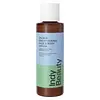What's inside
What's inside
 Key Ingredients
Key Ingredients

 Benefits
Benefits

 Concerns
Concerns

 Ingredients Side-by-side
Ingredients Side-by-side

Water
Skin ConditioningGlycerin
HumectantIsopropyl Palmitate
EmollientStearic Acid
CleansingDihydroxyacetone
Skin ConditioningDimethicone
EmollientGlycol Stearate
EmollientPEG-100 Stearate
Caprylyl Glycol
EmollientCaramel
Cosmetic ColorantCetyl Alcohol
EmollientCitric Acid
BufferingDimethiconol
EmollientDisodium EDTA
Glyceryl Stearate
EmollientHydroxyethyl Acrylate/Sodium Acryloyldimethyl Taurate Copolymer
Emulsion StabilisingHydroxystearic Acid
CleansingIsohexadecane
EmollientIsopropyl Myristate
EmollientMaltodextrin
AbsorbentPalmitic Acid
EmollientParfum
MaskingPhenoxyethanol
PreservativePolysorbate 60
EmulsifyingSodium Hydroxypropyl Starch Phosphate
AbrasiveSorbitan Isostearate
EmulsifyingStearamide Amp
Alpha-Isomethyl Ionone
PerfumingBenzyl Alcohol
PerfumingButylphenyl Methylpropional
PerfumingCitronellol
PerfumingCoumarin
PerfumingGeraniol
PerfumingHexyl Cinnamal
PerfumingLimonene
PerfumingLinalool
PerfumingCI 16255
Cosmetic ColorantCI 47005
Cosmetic ColorantWater, Glycerin, Isopropyl Palmitate, Stearic Acid, Dihydroxyacetone, Dimethicone, Glycol Stearate, PEG-100 Stearate, Caprylyl Glycol, Caramel, Cetyl Alcohol, Citric Acid, Dimethiconol, Disodium EDTA, Glyceryl Stearate, Hydroxyethyl Acrylate/Sodium Acryloyldimethyl Taurate Copolymer, Hydroxystearic Acid, Isohexadecane, Isopropyl Myristate, Maltodextrin, Palmitic Acid, Parfum, Phenoxyethanol, Polysorbate 60, Sodium Hydroxypropyl Starch Phosphate, Sorbitan Isostearate, Stearamide Amp, Alpha-Isomethyl Ionone, Benzyl Alcohol, Butylphenyl Methylpropional, Citronellol, Coumarin, Geraniol, Hexyl Cinnamal, Limonene, Linalool, CI 16255, CI 47005
Water
Skin ConditioningGlycerin
HumectantC15-19 Alkane
SolventSalicylic Acid
MaskingSteareth-2
EmulsifyingHydroxyethyl Acrylate/Sodium Acryloyldimethyl Taurate Copolymer
Emulsion StabilisingCaprylic/Capric Triglyceride
MaskingCetearyl Alcohol
EmollientSteareth-20
CleansingXylitylglucoside
HumectantSodium Hyaluronate
HumectantAnhydroxylitol
HumectantSodium Hydroxide
BufferingXylitol
HumectantCamellia Sinensis Leaf Extract
AntimicrobialXanthan Gum
EmulsifyingEthylhexylglycerin
Skin ConditioningPolysorbate 60
EmulsifyingSorbitan Isostearate
EmulsifyingSqualene
EmollientGlycine Soja Oil
EmollientGlucose
HumectantTocopherol
AntioxidantBeta-Sitosterol
Emulsion StabilisingPotassium Sorbate
PreservativeSodium Benzoate
MaskingPhenoxyethanol
PreservativeWater, Glycerin, C15-19 Alkane, Salicylic Acid, Steareth-2, Hydroxyethyl Acrylate/Sodium Acryloyldimethyl Taurate Copolymer, Caprylic/Capric Triglyceride, Cetearyl Alcohol, Steareth-20, Xylitylglucoside, Sodium Hyaluronate, Anhydroxylitol, Sodium Hydroxide, Xylitol, Camellia Sinensis Leaf Extract, Xanthan Gum, Ethylhexylglycerin, Polysorbate 60, Sorbitan Isostearate, Squalene, Glycine Soja Oil, Glucose, Tocopherol, Beta-Sitosterol, Potassium Sorbate, Sodium Benzoate, Phenoxyethanol
Ingredients Explained
These ingredients are found in both products.
Ingredients higher up in an ingredient list are typically present in a larger amount.
Glycerin is already naturally found in your skin. It helps moisturize and protect your skin.
A study from 2016 found glycerin to be more effective as a humectant than AHAs and hyaluronic acid.
As a humectant, it helps the skin stay hydrated by pulling moisture to your skin. The low molecular weight of glycerin allows it to pull moisture into the deeper layers of your skin.
Hydrated skin improves your skin barrier; Your skin barrier helps protect against irritants and bacteria.
Glycerin has also been found to have antimicrobial and antiviral properties. Due to these properties, glycerin is often used in wound and burn treatments.
In cosmetics, glycerin is usually derived from plants such as soybean or palm. However, it can also be sourced from animals, such as tallow or animal fat.
This ingredient is organic, colorless, odorless, and non-toxic.
Glycerin is the name for this ingredient in American English. British English uses Glycerol/Glycerine.
Learn more about GlycerinThis is a synthetic polymer. It helps improve the texture of products by adding thickness and gel-like feel.
It is also an emulsifer, meaning it prevents ingredients such as oil and water from separating. It also helps evenly disperse other ingredients.
Phenoxyethanol is a preservative that has germicide, antimicrobial, and aromatic properties. Studies show that phenoxyethanol can prevent microbial growth. By itself, it has a scent that is similar to that of a rose.
It's often used in formulations along with Caprylyl Glycol to preserve the shelf life of products.
Polysorbate 60 is used to help stabilize products. It is a surfactant and emulsifier. These properties help keep ingredients together in a product. Surfactants help reduce surface tension between ingredients with different states, such as liquids and solids. Emulsifiers help prevent oils and waters from separating.
Polysorbate 60 is sorbitol-based and created from the ethoxylation of sorbitan. Ethoxylation is a chemical reaction used to add ethylene oxide. Sorbitan is a the dehydrated version of sorbitol, a sugar found in fruits.
In this case, the 60 comes from reacting 60 units of ethylene oxide with sorbitan.
Polysorbates are commonly used in medicine and foods.
Learn more about Polysorbate 60Sorbitan Isostearate is an emulsifer and cleaning agent. It is created from isostearic acid and sorbitol.
As an emulsifier, Sorbitan Isostearate prevents oils and water from separating.
Due to its isostearic acid base, it may not be safe for Malassezia or fungal acne.
Learn more about Sorbitan IsostearateWater. It's the most common cosmetic ingredient of all. You'll usually see it at the top of ingredient lists, meaning that it makes up the largest part of the product.
So why is it so popular? Water most often acts as a solvent - this means that it helps dissolve other ingredients into the formulation.
You'll also recognize water as that liquid we all need to stay alive. If you see this, drink a glass of water. Stay hydrated!
Learn more about Water